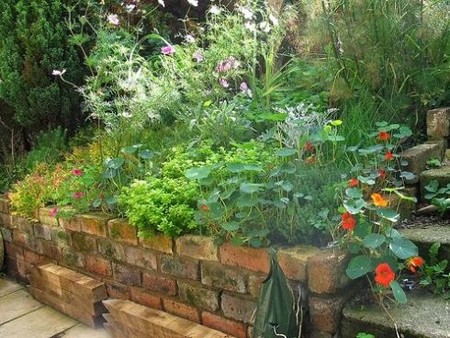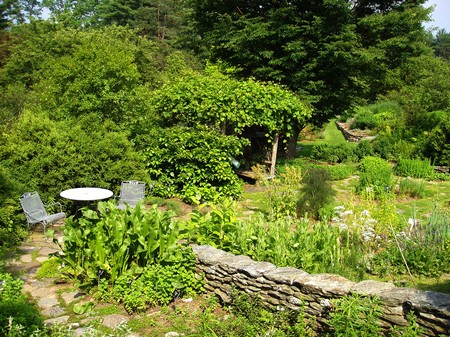Herbs can be grown in many places in the garden-as part of a vegetable plot, in beds near the kitchen door or in containers. But for a real herb feature, why not construct a simple cartwheel herb garden?
Step-by-step to creating a cartwheel herb garden
- During winter, dig an area 1.8-2.4m (6-8ft) square; mix in well-decomposed compost.
- In spring, rake the area level. Systematically tread over the surface.
- To mark a circle, use a piece of string 60-75cm long tied to a cane at each end. Insert one cane in the centre of the proposed cartwheel area, then scribe a line to indicate the rim.
- Mark the positions of the spokes, as well as the hub – form a circle 23-30cm (9-12in) wide at the centre.
- If the planting areas are too large, use pebbles to divide them into inner and outer segments.
- Water the plants, while still in their pots, the day before planting them.
- Position the plants (still in their pots) and adjust them into an attractive display.
- Use a trowel to plant the herbs.
- Water the plants to settle them in.
Plants for cartwheel herb gardens
Low-growing herbs with attractive leaves create the best displays; tall types, such as sage, can be kept low by pinching off the tips of shoots to encourage bushiness.
Constraining some herbs to the confines of a cartwheel is against their nature, so be prepared to replant the wheel after three years with young plants. Here are a few herbs to consider:
- Chives: Perennial, with grass-like, tubular, green leaves and rose-pink flowers during early and mid-summer.
- Mints: Range of perennial plants with attractive leaves. They are invasive.
- Parsley: A biennial usually grown as a hardy annual, with bright green foliage.
- Rosemary: Evergreen shrub, with aromatic, dark green leaves and mauve flowers mainly in spring.
- Sage: Shrubby with grey-green leaves; it is the variegated forms that create the most spectacular displays.
- Thyme: Creeping, evergreen, mat-forming shrub with dark green leaves. Several forms, with colored leaves: Thymusx citriodorus ‘Aureus’ (golden leaves); T. x C. ‘Silver Queen’ (variegated leaves).
Categories
Advertisements
Recent Articles
 How to Understand Bed Sizes – A Small Guide
How to Understand Bed Sizes – A Small Guide How to Select Some Must Have Kitchen Accessories
How to Select Some Must Have Kitchen Accessories Best Way to Change a Car Tire
Best Way to Change a Car Tire Best Way to Write an Affirmation
Best Way to Write an Affirmation Best Way to Take Charge of Your Financial Life
Best Way to Take Charge of Your Financial Life Best Way to Survive a Party When You Don’t Know Anyone
Best Way to Survive a Party When You Don’t Know Anyone Best Way to Stop Self Sabotaging Yourself
Best Way to Stop Self Sabotaging Yourself Best Way to Start Journal Writing
Best Way to Start Journal Writing Best Way to Speak with a Powerful Voice
Best Way to Speak with a Powerful Voice Best Way to Simplify Your Life
Best Way to Simplify Your Life Best Way to Respond to a Put-Down
Best Way to Respond to a Put-Down Best Way to Reduce Acne Breakouts
Best Way to Reduce Acne Breakouts Best Way to Recover from Dining Disasters
Best Way to Recover from Dining Disasters Best Way to Quit Your Job Gracefully
Best Way to Quit Your Job Gracefully Best Way to Make Your Own Website
Best Way to Make Your Own Website
Tags
Acid Reflux
Allergy
Aromatherapy
Baby
Baby Learn
Beauty
Bed Rest
Child
Decorate Garden
Depression
Develop Baby Skills
Exercise
Feng Shui
Garden
Golf
Golf Swing
Growing Herbs
Hair
Herbs
Improve Garden
Interview
Interviews
Kitchen
Life
Makeup
Massage
Meditation
Newborn Baby
Plant
plants
Pregnancy
Reduce Stress
Relax
Sales Team
School
Skin
Skin Care
Stress
Stress Reducing
Teach Child
Teacher
Teaching
Train Dog
Understand Baby
Vegetable Garden



Leave a Reply